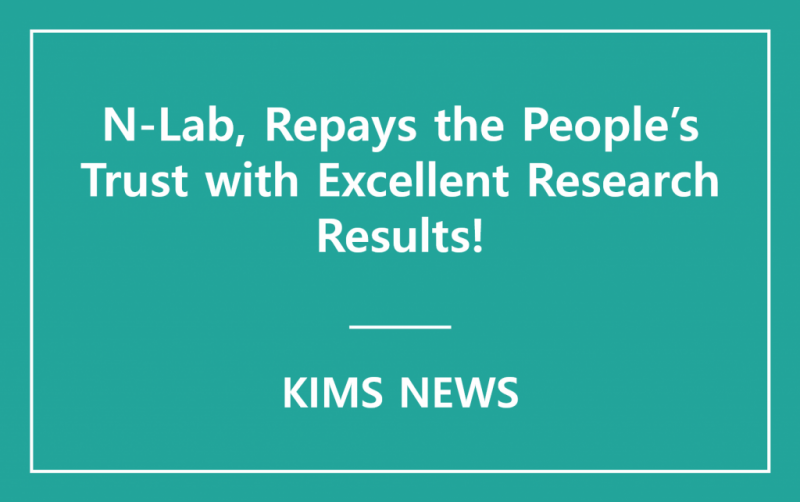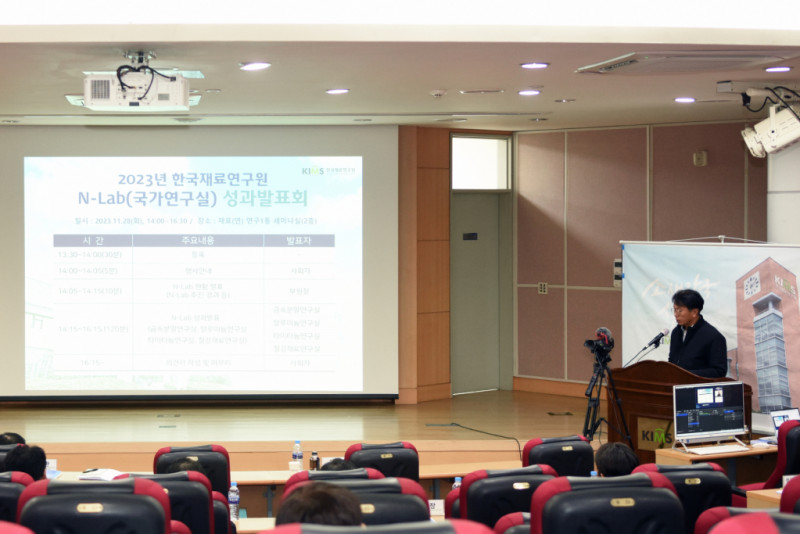None R&D | KIMS Hosts N-Lab. Research Accomplishment Presentation Meeting
Page info
Date23-12-01 14:32 Hit137Link
Contents
|
The Korea Institute of Materials Science(KIMS), a government-funded research institute under the Ministry of Science and ICT held a 2023 N-Lab. research accomplishment presentation meeting on Tuesday, November 28, at the seminar room on the second floor of KIMS Research Building 1 in Changwon, Gyeongnam. This presentation meeting which started in 2021 and marks its third anniversary this year was held with the purpose of announcing the results of the N-Lab.(national laboratory) conducted by KIMS and sharing opinions with experts from industry, academia, research, and government in the field of materials, parts, and equipment.
In 2019, the government established the R&D Investment Strategy and Innovation Plan for Materials, Parts, and Equipment in response to Japan's policy of restricting exports of key items to Korea. Additionally, the government designated N-Lab., N-Facility, and N-Team to consolidate the capabilities of representative laboratories and research facilities in the fields of materials, parts, and equipment at the national level, with the aim of strengthening national self-reliance. This initiative is also intended to facilitate stable research on core items and enable quick responses to emergencies such as Japanese export restrictions.
The purpose of this meeting is to present research results and share opinions with experts from industry, academia, research, and government.
The Department of Steel has developed an artificial neural network-based prediction technology for specialized properties of advanced steel and applied it to the design of economical high-performance stainless steel, next-generation heat-resistant steel for steam turbine rotor blades, and advanced specialty steel alloys for construction. This achievement has resulted in technological independence in core steel materials. The advantage of this technology is that it not only predicts conventional room-temperature tensile properties but also encompasses high-grade steel-specific properties such as pitting resistance and low-temperature impact required by economic stainless steels, creep properties required by heat-resistant steels, and high-temperature tensile properties required by special-shaped steels with high accuracy through artificial intelligence (AI) technology. These predictions can be quickly reflected in alloy development.
The Department of Titanium has developed a technology for manufacturing 900 MPa microcrystalline pure titanium material using scrap as raw material. It has the advantage of being able to mass-produce 900MPa pure titanium with strength and elasticity equivalent to expensive titanium alloys containing rare earth metals using existing equipment at industrial sites. The technology has broad applications in aerospace, biomedical, and consumer products.
The Department of Aluminum has successfully developed an aluminum alloy with dramatically improved durability for electric vehicles. This technology is expected to enhance the reliability of electric vehicle battery exterior materials, contributing to the prevention of major disasters caused by electric vehicle accidents-a recently significant social problem. Various trace elements have been added to the existing 6000 series aluminum alloy to increase its thermal durability.
Based on carbide nanopowder and densification sintering technology, the Department of Metal Powder has developed high-hardness tools such as a high-precision knife with a thickness of 100μm or less and an ultra-high-pressure water jet nozzle with a diameter of 0.1mm or less, capable of cutting Multi-Layer Ceramic Capacitors(MLCC). Additionally, the department has achieved a groundbreaking milestone by developing the world's first high-performance permanent magnet that reduces expensive rare earth(Nd) by more than 30%. Furthermore, they have successfully created a rotor(permanent magnet) and stator(soft magnet) using high-property soft magnetic materials, thereby acquiring core drive materials for future vehicles.
Dr. Jung-hwan Lee, the president of KIMS said, "Since the designation and operation of the National Research Infrastructure, we have witnessed a significant increase in interest, R&D, and support for core technologies of materials, parts, and equipment.”He added,“As many excellent results are being achieved through systematic operation and in-depth research, we will not be satisfied with this and will do our best to work harder to achieve results that the general public can feel.”


